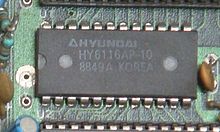Difference between SRAM and DRAM
Key Difference: Static RAM (SRAM) and Dynamic RAM (DRAM) are two types of RAM (Random Access Memory). They both are different from each other in many contexts like speed, capacity, etc. These differences occur due the difference in the technique which is used to hold data. DRAM makes use of single transistor and capacitor for each memory cell, whereas each memory cell of SRAM makes use of an array of 6 transistors. DRAM needs refreshing, whereas SRAM does not require refreshing of the memory cell. Both retain data till the time they are supplied with power.
 Semiconductor memory can be classified into volatile and non-volatile memories. Random memories (RAM) of volatile memory are of two types – SRAM and DRAM. RAM means that individual memory locations are accessed directly by address. SRAM stands for static random access memory and DRAM stands for dynamic random access memory.
Semiconductor memory can be classified into volatile and non-volatile memories. Random memories (RAM) of volatile memory are of two types – SRAM and DRAM. RAM means that individual memory locations are accessed directly by address. SRAM stands for static random access memory and DRAM stands for dynamic random access memory.
These memories are Random Access Memory (RAM), and they are volatile, which means they are not retained for a longer time. RAM can also be referred to as a working memory storage area within the computer. SRAM and DRAM both loses data once the power is removed. However, DRAM needs to be refreshed periodically.
.jpg) The key difference between the two is the technology which is used for holding data. Due to this key difference, other differences arise too. SRAM makes use of latches in order to store data (transistor circuit), whereas DRAM uses capacitors for storing bits in the form of charge. SRAM uses normal high speed CMOS technology for construction, whereas DRAM uses Special DRAM processes for achieving optimized high density. Dynamic RAMs have a simple internal structure than in comparison to SRAMs.
The key difference between the two is the technology which is used for holding data. Due to this key difference, other differences arise too. SRAM makes use of latches in order to store data (transistor circuit), whereas DRAM uses capacitors for storing bits in the form of charge. SRAM uses normal high speed CMOS technology for construction, whereas DRAM uses Special DRAM processes for achieving optimized high density. Dynamic RAMs have a simple internal structure than in comparison to SRAMs.
SRAM is faster than in comparison to DRAM. However, DRAM is smaller as well as less expensive per bit. The cycle time of SRAM is greater than that of DRAM and DRAM has more capacity than SRAM. DRAM is used as the main memory, whereas on-chip caches are usually SRAMs.
SRAMs havs been primarily designed for fulfilling two main requirements – 1. To provide a direct interface with the CPU at speeds which cannot be achieved by DRAMs 2. To take place of DRAMs in those systems which need a low power consumption.
Comparison between SRAM (Static Random Access Memory) and DRAM (Dynamic Random Access Memory):
|
|
SRAM |
DRAM |
|
Definition |
It is a type of RAM. SRAM essentially uses latches to store charge.
|
It is also a type of RAM. DRAM makes use of capacitors to store bits in the form of charge. |
|
Speed |
Faster |
Slower |
|
Size |
Bigger |
Smaller |
|
Cost |
More expensive per bit |
Less expensive per bit |
|
Requirement of peripheral circuitary |
Comparatively less |
Comparatively more |
|
Type |
Comparatively less common |
Comparatively more common |
|
Capacity (same technology) |
Less |
5 to 10 times more than SRAM |
|
Applications |
Generally in smaller applications like CPU cache memory and hard drive buffers |
Commonly used as the main memory in personal computers |
|
Types |
Asynchronous SRAM Synchronous SRAM Pipeline Burst SRAM |
Fast Page Mode DRAM Extended Data Out DRAM Burst EDO DRSSM Synchronous DRAM |
|
Access |
Easy |
Harder |
|
Construction |
Difficult |
Simple |
|
Power Consumption |
Less |
More |
|
Density |
Low density/less memory per chip |
High density/more memory per chip |
Image Courtesy: wikipedia.org, s100computers.com









Comments
m aqib khan
Mon, 11/20/2017 - 21:16
I Am Awesome
Thu, 02/04/2016 - 14:23
thanks for these difference
deveshwar bansal
Thu, 11/20/2014 - 12:37
I REALLY COOMEND YOU FOR THE EXPALANATIONS BUT I STILL NEED MORE ABOT HARD WARE AND SOFTWARE
HUSSAINI MUHAMM...
Wed, 04/16/2014 - 17:29
Great article, but someone needs to fix the English errors. The meaning of some sentences isn't clear. (And I can't tell what they should say.)
Greg J.
Sun, 03/30/2014 - 17:33
Add new comment